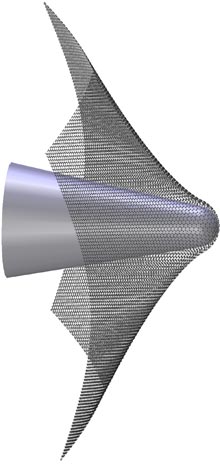C reative
Particle
Higgs
CPH Theory is based on Generalized light velocity from energy into mass.
CPH Theory in Journals
|
The Year in Materials
|
|
The Year in MaterialsStretchable electronics and the strongest material ever were just two achievements of 2008. Graphene, the material behind one of our 10 emerging technologies of 2008, stayed in the news all year. In July, researchers who poked the single-atom-thick carbon sheets with the tip of an atomic force microscope confirmed that graphene is thestrongest material ever tested. But most of the graphene community, includingKostya Novoselov, one of the first to make graphene and one of TR's top 35 innovators under 35 in 2008, is interested in graphene's electrical properties. Last month, two separate groups of researchers reported that they had made fast graphene transistors that could be used for wireless communications. Other researchers addressed the problem of manufacturing graphene. Novoselov and his collaborators originally made the single-atom-thick hydrocarbon sheets by crushing graphite between two layers of tape. But more scalable graphene-manufacturing technologies will be needed for the material to be adopted by the chip industry. One group at the University of California, Los Angeles, developed a simple method for making large sheets of graphene by dissolving graphite in hydrazine.
World’s strongest material: Researchers
who probed single-atom-thick graphene with a sharp diamond tip
found that it’s the strongest material ever tested. The
illustration shows the atomic structure of graphene, a mesh of
carbon and hydrogen atoms.
Nanomedicine and Nanomaterials Safety However, there was some bad news this year about the safety of nanomaterials. Two studies in mice suggested that carbon nanotubes could behave like asbestos in the lungs, causing cancer. Whether the nanotubes can, like asbestos, be easily inhaled is just one of many remaining questions. Nanomaterials are diverse in their chemistry and structure, and it's difficult to make generalizations about their safety. One study this year attempted to address this diversity. Researchers developed a method forscreening a diverse group of nanomaterials in large numbers and in many kinds of human cells.
Stretchable, Flexible, Wearable Electronics By coating cotton thread with a mixture of carbon nanotubes and a conductive polymer, researchers in Michigan made fabrics that can perform sophisticated computation and act as wearable biosensors whose sensitivity to biological molecules rivals that of conventional diagnostics.
Source: http://www.technologyreview.com/computing/21900/?a=f
1 2 3 4 5 6 7 8 9 10 Newest articles
|
|
Sub quantum space and interactions from photon to fermions and bosons |
Interesting articles
Since 1962 I doubted on Newton's laws. I did not accept the infinitive speed and I found un-vivid the laws of gravity and time.
I learned the Einstein's Relativity, thus I found some answers for my questions. But, I had another doubt of Infinitive Mass-Energy. And I wanted to know why light has stable speed?

